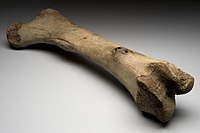
Photo from wikipedia
Abstract To understand the failure mechanism of trapezoidal opening in rock engineering, the fracture evolution of rock containing a cavity under compression was investigated analytically and experimentally in this study.… Click to show full abstract
Abstract To understand the failure mechanism of trapezoidal opening in rock engineering, the fracture evolution of rock containing a cavity under compression was investigated analytically and experimentally in this study. Firstly, the complex variable theory was employed to find the general solution for rock stress around a trapezoidal cavity under biaxial stresses. Secondly, a series of uniaxial compression tests were carried out on prismatic sandstone specimens with a circular or a trapezoidal cavity. During the tests, the acoustic emission (AE) and digital image correlation (DIC) techniques were jointly applied to record and analyze the damage and fracturing behavior. The results showed that both the cavity shape and lateral stress ratio have a significant effect on the stress distribution around the cavity. The fracture evolution starts from primary tensile cracks through compressive fractures and secondary tensile cracks to shear cracks, which can be well explained by the stress distribution. The primary and secondary tensile cracks are not responsible for the ultimate macro failure, which is dominated by the shear cracks. Compared to the specimens with a circular cavity, the crack initiation stress of the specimens containing a trapezoidal cavity is large, but the crack closure and the crack damage stresses are small, indicating relatively poor mechanical properties.
Journal Title: Theoretical and Applied Fracture Mechanics
Year Published: 2019
Link to full text (if available)
Share on Social Media: Sign Up to like & get
recommendations!